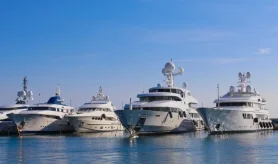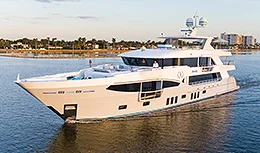- Alaskan Yachts
- Azimut Yachts
- Back Cove Yachts
- Beneteau Yachts
- Benetti Superyachts
- Bertram Yachts
- Boston Whaler
- Broward Yachts
- Buddy Davis Sportfish
- Burger Yachts
- Cabo Yachts
- Catamarans
- Carver Motoryachts
- Center Console
- Chris-Craft Yachts
- Cruisers Yachts
- DeFever Trawlers
- Dufour Sailboats
- Fairline Yachts
- Feadship Yachts
- Ferretti Yachts
- Filippetti Yachts
- Formula Yachts
- Fountaine Pajot Cats
- Grady-White
- Grand Banks Trawlers
- Hargrave Yachts
- Hatteras Yachts
- Hinckley Picnic Boats
- Horizon Yachts
- Hydra-Sports
- Intrepid Boats
- Jarrett Bay Sportfish
- Jeanneau Yachts
- Kadey-Krogen Trawlers
- Lazzara Yachts
- Lekker Boats
- Luhrs Sportfish
- Marlow Yachts
- Maritimo Yachts
- Marquis Yachts
- Mazu Yachts
- McKinna Motoryachts
- Meridian Yachts
- Midnight Express
- MJM Yachts
- Mochi Craft
- Neptunus Motoryachts
- Nordhavn Trawlers
- Nordic Tugs
- Numarine Yachts
- Ocean Alexander Yachts
- Ocean King
- Offshore Yachts
- Outer Reef
- Oyster Sailing Yachts
- Pacific Mariner Yachts
- Palmer Johnson Yachts
February 21, 2020 8:56 pm
Superyacht ownership is a dream for many. For the lucky few who find themselves in a position to realize that dream, the Denison team has already produced papers in this series dealing with the purchase process, costs of ownership, and the charter process. This next article in the series will deal with the maritime compliance challenges faced by owners and their representatives. Many owners will take the perspective that they are paying a crew to deal with compliance matters, and that is not wrong, but a well-informed owner will be in a position to support their crew if they have a basic understanding of the environment they are operating in.
Maritime compliance is an arcane subject, with a history that goes back literally hundreds of years and which can change based on local, national, and international legislation. There are many abbreviations and other jargon which can make it seem even more impenetrable; the intention of this article is to cut through some of that and provide the “10,000-foot” view which will help owners and their representatives to support their crew in dealing with the compliance map on their yacht.

Classification Societies
Ship classification is a service with a long history, the classification societies provide a third-party assurance and oversight of the construction and maintenance of the hull and ship’s equipment. Classification fees are paid by ship owners, so it is important for the yacht owner to remember that this service is a “client relationship”.
Insurance – Most yacht insurance policies will contain a warranty that if the vessel is “in class” at the inception of the policy, the owner warrants that class will be maintained. The upshot of this is that if the owner allows class to lapse, then his insurance policy is void.
Asset Value – Obviously yacht owners are motivated to maintain asset value in the yacht; the ongoing maintenance of the class history of the yacht helps to deliver that. When looking at yachts to buy, check the price of similar size vessels that are both in class or not. Depending on size or age, there could be millions of dollars difference, so the cost of maintaining classification delivers that value.
Learn More About:

Flag State + Port State
Flag State – The flag state of the yacht determines from where compliance is administered. At the time of purchase, the buyer’s maritime attorney will advise on choice of flag, which may be impacted by choice of ownership structure, cruising location, and other requirements. After registration under the new ownership, the flag will then administer statutory compliance requirements based on the tonnage, service, and other metrics, as mentioned above.
Port State – In the context of this circumstance, the port state can be seen as the “enforcer”. The port state is wherever the yacht happens to be at any time and a “Port State Inspection” can be imposed on ships whereby inspectors come onboard and check that the compliance administered by the flag state is in order.
Learn More About:

Crew Compliance
Crew compliance is mostly handled by two conventions:
Standards of Training, Certification and Watchkeeping (STCW) – This convention lays out the requirements for the captain’s license, qualifications for engineers, basic levels of safety, and other training requirements for other crew.
Maritime Labour Convention (MLC) – Actually a convention issued by the International Labour Organization, the MLC caused a great deal of upheaval in yachting when it was first introduced as it appeared that most yachts would not be able to comply. The convention includes “hard” requirements such as living space, recreational areas, etc., as well as “soft” items such as employment benefits, medical care, vacation, etc.
Learn More About:

Pollution
Motivated as the maritime industry is to maintain the ocean, not only as a place of business but as a place of recreation, there are a number of pollution compliance requirements, which are principally administered by the flag state under the MARPOL convention.

Safety
The Safety of Life at Sea Convention (SOLAS) applies to all ships, but in many cases, the requirements are not practical for yachts, so many of the flag states which carry yachts in their register have developed codes of practice that have been registered with the IMO as carrying equivalence to the SOLAS code.
The safety code of practice includes numerous requirements that impact the vessel’s safety, such as stability, structural fire protection, machinery requirements, firefighting and lifesaving equipment, and navigation and radio equipment.
Learn More About:
Surveys + Certificates
The method of administering most of the yacht compliance requirements is through occasional surveys and audits, and the issue and endorsement of certificates that are carried onboard and available for inspection by port state inspectors. Different compliance requirements have different frequencies for their survey and audit, but most are issued in a five-year cycle, with surveys once per year in the cycle, followed by a more detailed “renewal” survey at the end of the cycle.
Learn More About:
Looking for more details?
Receive the complete Yacht Compliance Guide including:
- • Crew Compliance
- • Asset Value
- • International Conventions

This should not be considered a complete guide. For a better understanding of superyacht services, contact Ben Farnborough.1




![Yacht Compliance [Complete Guide]](https://cdn.denisonyachtsales.com/wp-content/uploads/2020/02/yacht-compliance-whitepaper-1.jpg)
![Yacht Compliance [Complete Guide] Share on Facebook](https://cdn.DenisonYachtSales.com/images/share1.svg)
![Yacht Compliance [Complete Guide] Share via Email](https://cdn.DenisonYachtSales.com/images/share2.svg)
![Yacht Compliance [Complete Guide] Share on Twitter](https://cdn.DenisonYachtSales.com/images/share3.svg)


